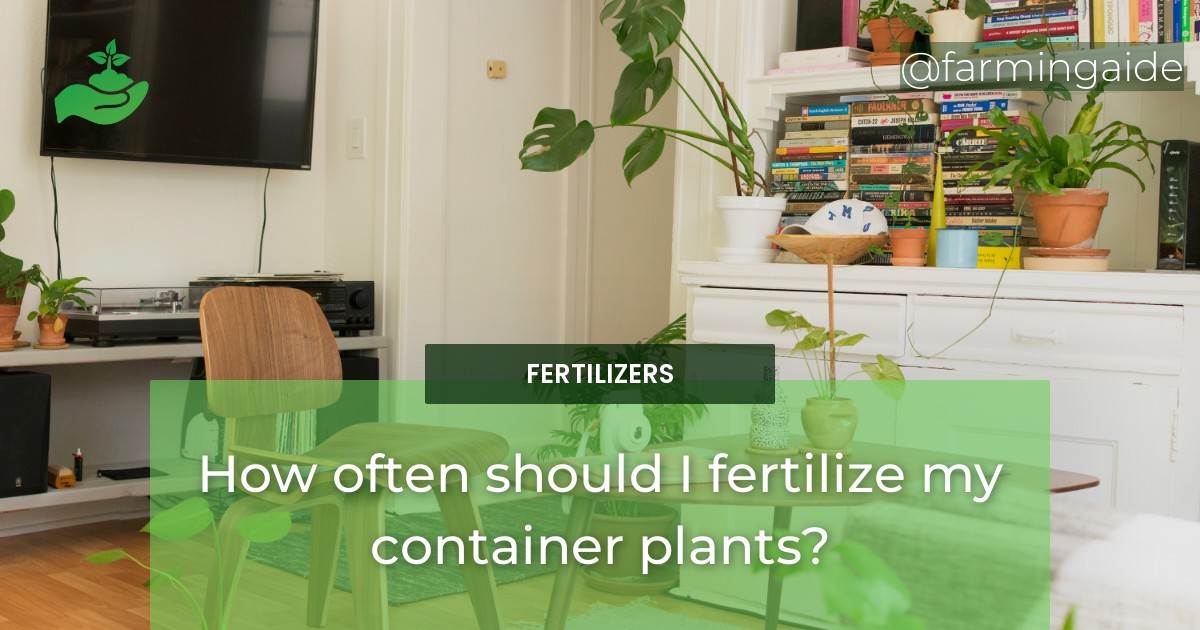Container gardening is an excellent way to grow plants in a limited space. However, for container plants to thrive, they require a regular supply of nutrients through fertilization. Fertilizing frequency for container plants depends on several factors, including the type of plant, growing conditions, and type of container. In this article, we will explore the factors that influence fertilizer frequency, types of fertilizers for container plants, and general guidelines for fertilizing container plants.
Frequency of Fertilizer Application for Container Plants
Importance of Fertilizing Container Plants
Container plants have limited soil volume, which means they have a limited supply of nutrients. Over time, the nutrients in the soil become depleted, which can lead to stunted growth and poor plant health. Fertilizing container plants provides them with the essential nutrients required for their growth, including nitrogen, phosphorus, and potassium.
Types of Fertilizers for Container Plants
Container plants require the same nutrients as plants grown in the ground, but their fertilizer requirements are slightly different. When selecting a fertilizer for container plants, consider the following:
- The type of plant
- The nutrient requirements of the plant
- The stage of plant growth
- The type of container
Organic fertilizers, such as compost or manure, are suitable for container plants. Slow-release fertilizers, which release nutrients over an extended period, are also suitable options. Avoid using garden soil or fertilizers designed for use in the ground.
Factors Affecting Fertilization Frequency
The frequency of fertilizer application for container plants depends on the following factors:
- The type of container
- The type of fertilizer
- The plant type
- Growing conditions
- Growth stage
- Environmental conditions
- Watering practices
General Guidelines for Fertilizing Container Plants
General guidelines for fertilizing container plants include:
- Fertilize container plants every two to four weeks during the growing season.
- Use a balanced fertilizer with equal parts nitrogen, phosphorus, and potassium.
- Avoid overfertilizing container plants, as this can lead to salt buildup and plant damage.
- Water container plants before and after fertilization to prevent fertilizer burn.
Signs of Overfertilization in Container Plants
Overfertilizing container plants can lead to salt buildup in the soil, which can damage the plant’s roots and prevent it from taking up water. Signs of overfertilization include:
- Wilting
- Brown leaf tips or edges
- Yellowing leaves
- Slow growth
- Root damage
Common Mistakes in Fertilizing Container Plants
Common mistakes when fertilizing container plants include:
- Using too much fertilizer
- Fertilizing too often
- Using the wrong type of fertilizer
- Not watering before or after fertilization
Factors Influencing Fertilization Frequency
Type of Container
The type of container influences the frequency of fertilizer application. Plastic containers retain moisture longer than clay pots, which means they require less frequent watering and fertilization. Plants grown in porous containers, such as terra cotta, require more frequent watering and fertilization.
Type of Fertilizer
The type of fertilizer influences the frequency of application. Slow-release fertilizers release nutrients over an extended period, reducing the need for frequent fertilization. Water-soluble fertilizers require more frequent application.
Plant Type
The type of plant influences the frequency of fertilizer application. Fast-growing plants, such as vegetables and annuals, require more frequent fertilization than slow-growing plants, such as succulents and cacti.
Growing Conditions
Growing conditions, such as light and temperature, influence the frequency of fertilizer application. Plants grown in low light conditions require less fertilizer than those grown in bright light. Similarly, plants grown in cooler temperatures require less fertilizer than those grown in warm temperatures.
Growth Stage
The growth stage influences the frequency of fertilizer application. Plants require more frequent fertilization during their active growth phase than during their dormant phase.
Environmental Conditions
Environmental conditions, such as humidity and wind, influence the frequency of fertilizer application. Plants grown in low humidity conditions require more frequent fertilization than those grown in high humidity conditions. Similarly, plants grown in windy conditions require more frequent fertilization.
Watering Practices
Watering practices influence the frequency of fertilizer application. Overwatering can lead to nutrient leaching, which increases the need for frequent fertilization. Underwatering can lead to nutrient buildup, which reduces the need for frequent fertilization.
ALSO READ
Conclusion
Fertilizing container plants is essential for their growth and health. The frequency of fertilizer application depends on several factors, including the type of container, type of fertilizer, plant type, growing conditions, growth stage, environmental conditions, and watering practices. By following general guidelines for fertilizing container plants and avoiding common mistakes, you can ensure your container plants receive the nutrients they need to thrive.
RELATED ARTICLES:


